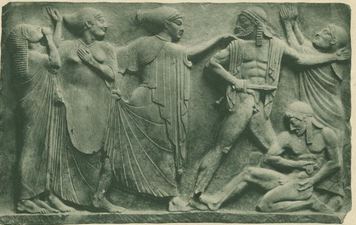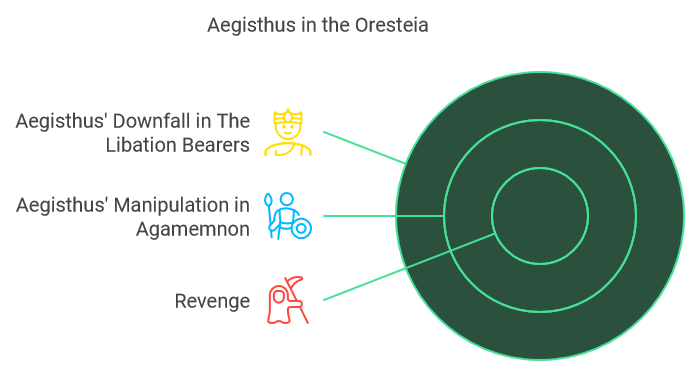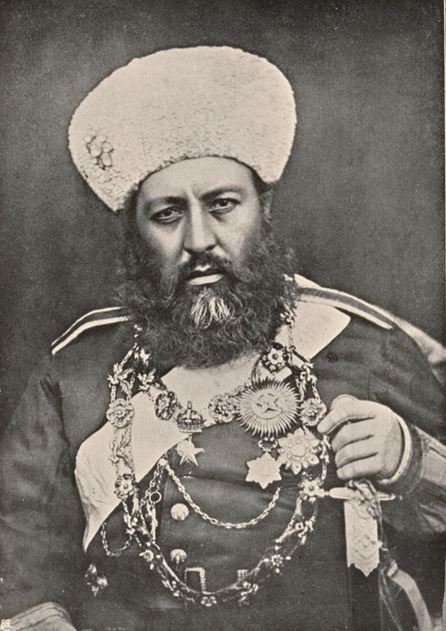Aegisthus is a significant figure in Greek mythology, remembered primarily for his role in the infamous murder of King Agamemnon, the leader of the Greek forces in the Trojan War. His actions are deeply intertwined with his illicit relationship with Clytemnestra, Agamemnon’s wife, with whom he conspired to carry out the murder. Aegisthus’ tale is one of betrayal, vengeance, and tragedy, as his deeds play a crucial part in the ongoing cycle of revenge within the House of Atreus, one of the most ill-fated dynasties in Greek mythology. His story exemplifies the themes of familial curses, political ambition, and the destructive consequences of revenge.
1. Early Life and Background
Cursed Lineage
Aegisthus’ life was marked by a cursed lineage from birth. He was born into the House of Atreus, a family plagued by blood feuds and violence. His father, Thyestes, had a bitter and deadly rivalry with his brother Atreus, who ruled as the king of Mycenae. The feud escalated to a horrific point when Atreus, in an act of unimaginable cruelty, tricked Thyestes into eating his own sons during a banquet. This gruesome betrayal led Thyestes to seek revenge in an equally dark manner, setting the stage for Aegisthus’ troubled existence.
The Incestuous Birth
In his quest for vengeance against Atreus, Thyestes committed an act of incest with his own daughter, Pelopia, to father Aegisthus. This union was not born out of love but rather a calculated move to bring about the downfall of Atreus. Thus, Aegisthus’ birth was rooted in a complex web of revenge and familial betrayal, foreshadowing the tragic and violent path his life would take.
Raised by Atreus
After his birth, Aegisthus was abandoned by his mother Pelopia, and he was taken in by shepherds. By a twist of fate, Aegisthus was later discovered and raised in the household of none other than Atreus, the very man Thyestes sought to destroy. Unaware of Aegisthus’ true identity, Atreus raised him as his own, a cruel irony that added yet another layer of tragedy to Aegisthus’ life.
Discovery and Revenge
As Aegisthus grew older, he eventually uncovered the truth about his lineage and his father’s suffering at the hands of Atreus. Consumed by the legacy of vengeance passed down from Thyestes, Aegisthus fulfilled his father’s desire for retribution by murdering Atreus. With this act of revenge, Aegisthus not only avenged his father but also claimed the throne of Mycenae, securing his place in the cycle of violence that had consumed the House of Atreus for generations.
2. Role in the Murder of Agamemnon
Betrayal of Agamemnon
Aegisthus is most infamously known for his role in the assassination of King Agamemnon, the commander of the Greek forces during the Trojan War. Upon Agamemnon’s victorious return to Mycenae after the war, Aegisthus, in collaboration with Clytemnestra, Agamemnon’s wife, conspired to murder him. The plot was one of calculated betrayal, designed to eliminate Agamemnon and secure Aegisthus’ rule over Mycenae.
Affair with Clytemnestra
While Agamemnon was away at war, Aegisthus and Clytemnestra began an illicit affair. Their relationship flourished in the king’s absence, and it became the foundation for their treacherous plot. Aegisthus provided Clytemnestra with support and a shared desire for revenge, cementing their partnership. The affair not only served as a personal betrayal but also laid the groundwork for Aegisthus’ greater ambitions of usurping Agamemnon’s throne.
Motives for Murder
- Clytemnestra’s Personal Revenge: One of the primary motivations behind Clytemnestra’s involvement in the murder was her deep resentment toward Agamemnon for the sacrifice of their daughter, Iphigenia. To ensure favorable winds for the Greek fleet to sail to Troy, Agamemnon had offered Iphigenia as a sacrifice to the goddess Artemis. This act left Clytemnestra seething with anger and grief, fueling her desire to see her husband dead.
- Aegisthus’ Political Ambitions: For Aegisthus, the murder of Agamemnon was driven more by political aspirations than personal revenge. As the son of Thyestes, who had once been in conflict with Agamemnon’s father, Atreus, Aegisthus sought to seize the throne of Mycenae and avenge the wrongs done to his family. By eliminating Agamemnon, Aegisthus could finally take control of the kingdom, fulfilling both his father’s legacy and his own lust for power.
The Murder Scene
The murder of Agamemnon is often portrayed as a cowardly and treacherous act. Upon his return from Troy, Agamemnon was welcomed into his palace by Clytemnestra, who feigned loyalty and hospitality. Depending on the version of the myth, the murder took place either during a banquet or while Agamemnon was bathing. In these accounts, Agamemnon was defenseless, making the murder all the more sinister. Aegisthus and Clytemnestra struck at a moment when the king was most vulnerable, ensuring their plot succeeded without resistance.

3. Aftermath and Death
Cycle of Vengeance
The murder of Agamemnon set in motion a vicious cycle of vengeance within the House of Atreus. The violent act committed by Aegisthus and Clytemnestra could not go unanswered, as the curse on the family dictated that bloodshed would beget further bloodshed. This ongoing cycle of revenge would ultimately lead to their downfall.
Orestes’ Revenge
Agamemnon’s son, Orestes, returned to Mycenae with his sister Electra to avenge their father’s death. With the support of Electra and the guidance of the god Apollo, Orestes confronted Aegisthus and Clytemnestra. In a dramatic act of retribution, Orestes killed both Aegisthus and his own mother, bringing an end to their treachery. This act of revenge mirrored the very cycle that had defined the House of Atreus for generations, where one murder was answered by another.
The Death of Aegisthus
Aegisthus met his fate at the hands of Orestes, who delivered the final blow in the saga of vengeance. His death marked the end of Aegisthus’ ambitions and the bloody chapter of his betrayal. Orestes’ act of vengeance was not only a personal one but also a fulfillment of the divine will, as the gods had decreed that Aegisthus must pay for his crimes.
Divine Retribution
Aegisthus’ death was seen as divine retribution for his betrayal and treachery. In Greek mythology, the gods often played a role in ensuring justice was served, and Aegisthus’ downfall was no exception. His role in the murder of Agamemnon, coupled with his affair with Clytemnestra, made him a symbol of dishonor and deceit. His death at the hands of Orestes was viewed as the natural consequence of his actions, bringing a sense of cosmic justice to the tragic events of the House of Atreus.

4. Aegisthus in Greek Tragedy
Role in Aeschylus’ Oresteia
Aegisthus plays a pivotal role in Aeschylus’ Oresteia trilogy, which explores the aftermath of Agamemnon’s murder and the cycle of vengeance that follows.
- In Agamemnon: Aegisthus is depicted as a secondary yet essential figure, operating behind Clytemnestra. While Clytemnestra takes center stage in carrying out the murder, Aegisthus’ presence symbolizes the fulfillment of the curse on the House of Atreus. His role is one of quiet manipulation, waiting for the moment to take the throne after Agamemnon’s death. In this play, Aegisthus represents the opportunistic nature of revenge, acting as both Clytemnestra’s lover and her co-conspirator.
- In The Libation Bearers: The second play of the trilogy, The Libation Bearers, brings Aegisthus’ downfall. After Agamemnon’s murder, Orestes returns to Mycenae to avenge his father, as commanded by Apollo. Aegisthus is killed by Orestes, marking the end of his brief rule and the continuation of the revenge cycle. His death serves as a crucial moment in the tragedy, highlighting the inevitability of retribution in Greek mythology. Aegisthus, who once orchestrated a murder to seize power, now becomes a victim of the same forces of vengeance.
Other Depictions
Beyond Aeschylus, Aegisthus also appears in the works of other Greek tragedians, including Sophocles and Euripides. In these plays, the theme of revenge in the House of Atreus continues to unfold.
- Sophocles: Aegisthus’ role is referenced in Electra, where the focus is on Orestes and Electra’s plan to avenge their father. Here, Aegisthus is depicted as a villainous figure whose actions have torn the family apart, reinforcing the image of a man whose betrayal has set the stage for further bloodshed.
- Euripides: In Electra, Euripides also highlights Aegisthus as a central antagonist. His relationship with Clytemnestra and his murder of Agamemnon are portrayed as acts of treachery, further entangling him in the web of familial curses and divine retribution. As in other versions of the myth, Aegisthus’ eventual death at the hands of Orestes signifies the inescapable nature of the cycle of revenge that plagues the House of Atreus.
5. Conclusion
Aegisthus stands as a symbol of betrayal, revenge, and the destructive power of family curses in Greek mythology. His involvement in the murder of Agamemnon, his illicit relationship with Clytemnestra, and his eventual death at the hands of Orestes all reflect the recurring themes of vengeance and retribution that dominate the myths of the House of Atreus. Aegisthus’ legacy is one of treachery, a man driven by ambition and consumed by the same cycle of violence that he helped perpetuate.
His story fits seamlessly into the broader themes of Greek tragedy, where human actions are intertwined with divine justice, and no crime goes unpunished. In the end, Aegisthus’ fate exemplifies the tragic consequences of betrayal, showing that even those who rise to power through deceit must ultimately face their downfall.
FAQ
1. Who was Aegisthus in Greek mythology?
Aegisthus was a figure from Greek mythology, known for his role in the murder of King Agamemnon and his relationship with Clytemnestra, Agamemnon’s wife. He was part of the cursed House of Atreus, marked by a cycle of betrayal and revenge.
2. What was Aegisthus’ relationship with Clytemnestra?
Aegisthus had an illicit affair with Clytemnestra, Agamemnon’s wife, while Agamemnon was away during the Trojan War. Together, they plotted and carried out Agamemnon’s murder upon his return.
3. Why did Aegisthus kill Agamemnon?
Aegisthus murdered Agamemnon both for political reasons and to fulfill personal revenge. He sought to claim the throne of Mycenae, and his involvement with Clytemnestra provided the perfect opportunity. Clytemnestra also had personal reasons for the murder, as Agamemnon had sacrificed their daughter, Iphigenia, to secure favorable winds for the Greek fleet during the Trojan War.
4. How did Aegisthus die?
Aegisthus was killed by Orestes, Agamemnon’s son, as an act of revenge for his father’s murder. Orestes returned to Mycenae with his sister Electra to avenge Agamemnon’s death, fulfilling the cycle of vengeance in the House of Atreus.
5. What role does Aegisthus play in Greek tragedies?
Aegisthus appears in several Greek tragedies, most notably in Aeschylus’ Oresteia trilogy. In Agamemnon, he is a secondary but crucial character, and in The Libation Bearers, he is killed by Orestes. His character is also referenced in plays by Sophocles and Euripides, where he continues to be portrayed as a figure of treachery and betrayal.
6. What is the curse of the House of Atreus?
The House of Atreus is one of the most tragic families in Greek mythology, plagued by a cycle of betrayal, murder, and revenge. Aegisthus was born into this cursed lineage, which included a bitter rivalry between his father Thyestes and his uncle Atreus, leading to a series of horrific events, including incest, cannibalism, and murder.
7. What was Aegisthus’ motive for seizing the throne of Mycenae?
Aegisthus sought power and revenge. As the son of Thyestes, who had been wronged by Agamemnon’s father Atreus, Aegisthus had a personal vendetta. By killing Agamemnon and seizing the throne, he aimed to avenge his father and claim power for himself.
8. Was Aegisthus a villain in Greek mythology?
Aegisthus is often depicted as a villain due to his betrayal of Agamemnon and his role in the murder. However, like many characters in Greek mythology, his actions were driven by the curse on his family, making him a complex figure shaped by fate and revenge.




